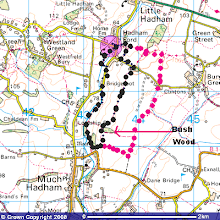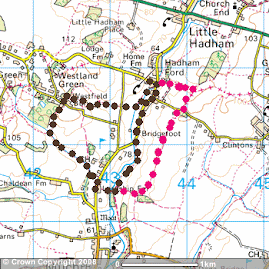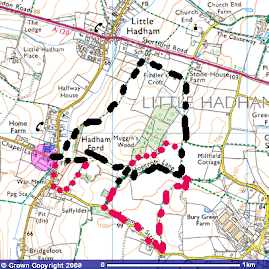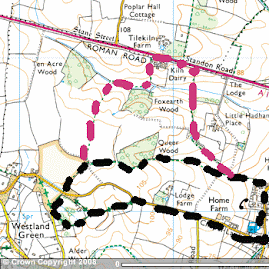The 2nd quarter of the year began on a relatively high note, with moths taken every night between 1st of April and 26th before the temperatures dropped again and April concluded with highs of 3C and no moths recorded between 27th and 30th.
The first New for year (NFY) was taken to the portable 15W actinic heath trap set on the local golf course, a Red green carpet. where also a new for my parish records (NFPR) micro was captured, an
Agpnopterix ocellana. This is a moth that has become more prevalent in Herts over the last few years, so just a matter of time before I took one. Indeed, I took another at another site the following evening, where I also recorded
Emmelina monodactyla as NFY and Early grey. a genital dissection on the 7th on another Agonopterix species showed ot to be just a
A. heracliana but a Water carpet from Millennium Wood to a headtorch and net was pleasing. The first double striped pug of the year also taken to the 125W skinner trap set in the garden.
On the 13tha Brindled pug made the year list, the following night a Nut tree tussock. The garden gave up both Streamer and Muslin moth on the 17th before a forced stop in trapping as I and 2 friends went off to Porto for a few days of port tasting to celebrate my 60th birthday. All good fun before a return on the 21st and an
Eriocrania subpurperella being NFY. A garden Lunar marbled brown on the 22nd, Purple thorn and Chinese character on the 23rd were the last 2 new records for April. On the 30th April my records showed a disappointing, but not unexpected list of 30 macros and 7 micros. My lowest return ever for the first 4 months of a year.
 |
| Red green carpet |
 |
| Red green carpet |
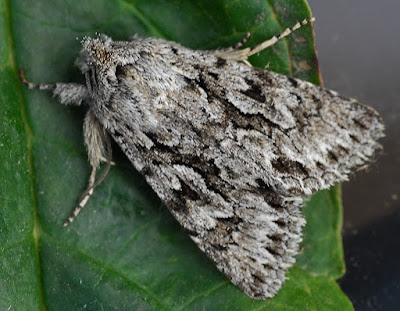 |
| Early grey |
 |
| Double striped pug |
 |
| Water carpet |
 |
| Nut tree tussock |
 |
| Lunar marbled brown |
 |
| Purple thorn |
 |
| Eriocrania subpurpurella |
Winter was still continuing as May began with a Scorched carpet braving the bitter cold on the 1st, a Latticed heath on the 3rd and the first of big numbers of Green carpet on the 4th.
On the 5th a Chocolate tip was a good moth, just a few recordings of this moth over the years before the first micro of May was captured at Westland Green on the 7th, an
Aphomia sociella along with a couple of
Agonopterix arenella. On the 8th a little sun in the garden meant I caught a glimpse of an
Esperia sulphurella and that night took Brimstone and Common carpet to the 15W trap and a Waved umber in the garden, as well as Pale tuccock and Red twin spot carpet. Things were now looking up and over the following week (9th - 14thMay) added 12 macros but still only more micro. On the 15th I was off with naturalist friend Anoma from Galle, Sri Lanka for a few days birding in North Norfolk, his first trip to the UK. We recorded over 100 species of bird but night time temps due to northerlies coming straight off the North Sea where we stayed at Blakeney meant it was pointless even putting the Heath trap out.
A couple of days respite from the really cold weather at home added two more macros (Shuttle shaped dart and Silver Y) before we headed off to Rome for a concert to mark Wendy's birthday. Great time in Rome, crap gig!
The garden gave up a few moths each night, some new for the year (White spotted pug, Poplar hawkmoth, Lychnis, Bright line brown eye and
Notocelia cynosbatella) up to the 23rd when everything suddenly began to take a turn for the better as temperatures slowly but surely increased. On the 23rd there were 6 NFY's including swallow prominent whilst the Heath trap was set in Suffyldes Wood on the 25th and I recorded 29 moths, but nothing new. The same night Light emerald and Bloodvein came to the garden skinner.
The 26th May was indeed the turning point, with 29 moths of 20 species being recorded at home. Mostly expected insects but a Haworth's pug was NFPR! Running both traps on the 27th gave a combined total of 80 moths and in this total were 15 NFY's. These included
Nemaphora degeerella, Pale oak beauty,
Plutella xylostella and Freyer's pug.
Running 2 traps the following night gave up even better totals and 9 NFY's but heavy rain and a strong breeze on the 29th curtailled the upturn. However, a
Tinea semifulvella was reacorded as NFY and a Pale prominent was the 1000th moth to be recorded in 2018. A moth taken in the garden seldomly seen was taken on the 30th, a Shears.
31st was good enough for a spot of daytime netting in grassland whereYellowshell,
Grapholitatenebrosana, Aethes smeathmanniana, Elasticha argentella and
Glyphipterix simplicella were all noted. Both traps were employed at night, with the Heath being placed in a new wood for me that I had recently been granted permission to trap. Negotiations involved buying Steve, the farmer, 2 pints of Old Speckled Hen! This was a good place, a hornbeam based woodland with a few conifers, oaks and ash but also plenty of rotting haybales which are used for pheasant rearing in the autumn. Therefore it was not a surprise to take 2
Monopsis obviella, a NFPR micro.
May ended with a mcuh more respectable total of 102 macros and 38 micros in a total of 1250 moths, still way down on the 2 previous years.
 |
| Chocolate tip |
 |
| Pale prominent |
 |
| Nemapogon cloacella |
 |
| Swallow prominent |
 |
| Clouded brindle |
 |
| Sandy carpet |
 |
Shears.
|
June came charging in: on the 1st a total of 73 moths of 37 species was, at that point, a year record, adding 3 macros and 2 micros to the year list before I headed off to Portland Bird Obs for the weekend, scoring with several new birds for the year, including a pair of Rosy starlings.
Back home to trap on the 3rd gave up the first Riband wave of the year, along with Willow beauty and
Hedya nubiferana. I'd be seeing plenty more of them throughout the next couple of months. I managed to get out over the next week or so on regular occasions, running the heath trap in a variety of local woods, meaning the 1500th moth of the year, a Setaceous Hebrew character was taken on the 6th June but it wasn't until the next evening I trapped my 4th NFPR, a pair of
Traxomera parasitella at Westland Green. In the garden skinner that night another NFPR,
Celypha cespitana.
By the end of the first week of June the totals had continue to rise, with NFY'S on a daily basis, as expected.
On the 10th, Wendy and I headed off for a lazy week camping on the Isle of Wight. We had both had a very hectic schedule since mid April and needed a few days doing little. The weather was perfect and I thought that was typical, great moths at home. Little did I know that the weather was just going to continue to improve up until the present day, warm nights and hot days without a drop of rain. Great mothing conditions.
On the 18th another NFPR,
Anarsia inoxiella represented my 366th micro for the parish. By now, I was taking up to 150 moths a night and adding plenty to the year list. The 200th moth species for 2018 was taken in the garden skinner on the 20th, a
Eucosma obumbratana
On the 21st I joined forces with local Herts moth-ers, Graeme and Stven and we ran 3 traps in Millennium Wood, a 150W Robinson, 125W skinner and 15W actinic heath. Over 300 insects recorded with many NFY'S but also
Coleophora anatipennella and
Epinotia bilunana being NFPR. Great evening. On the same night we ran another trap in Harvey's Wood where other NFPR's were taken:
Nematopogon metaxella, Minor shoulder knot
and
Orthotaenia undulana.
New records continued on a daily basis until the 25th when another NFPR:
Phtheochroa inopiana. The 250th species for 2018 was captured on the 26th June, a Epinotia nisella and the 3000th moth record of the year was on the 28th, a
Pleuropyta ruralis
Alder Wood that night gave up 91 of 51 species that night. A Lobster moth on the 29th was a good garden record and June finished on a high with 60 species coming to the garden Skinner.
So, the 2nd quarter finished with a relatively satisfactory 171 macros and 111micros. In amongst these were 14 new for parish records. I note I have omitted to mention that
Grapholita tenebrosana was an NFPR and totally missed mentioning
Spatalistis bifasciana
In total, I had recorded 3309 moths by the 31st June, still down on previous years, but with the weather set to continue long into July, chance of improving on last years records.
 |
| Lobster moth |
 |
| Herald |
 |
| Lilac beauty |
 |
| Ypsolopha dentella |
 |
| Oak hooktip |
 |
| Blue bordered carpet, having a very successful year. |
 |
| Udea olivalis |
 |
| Anania hortulata |
 |
| Adela crossella |

































































